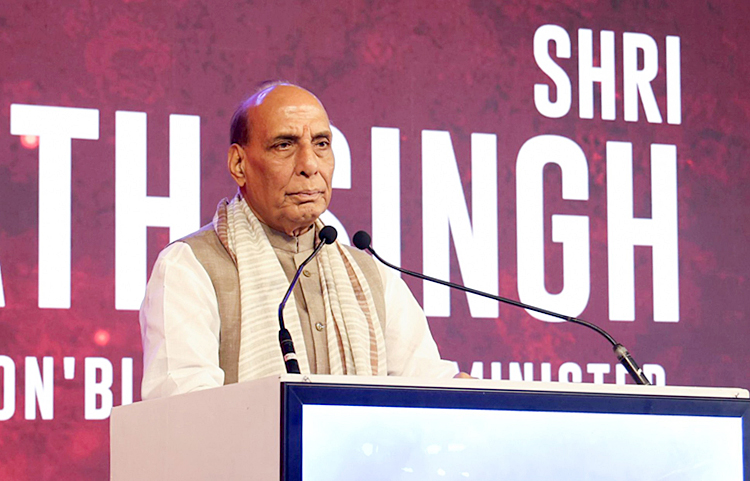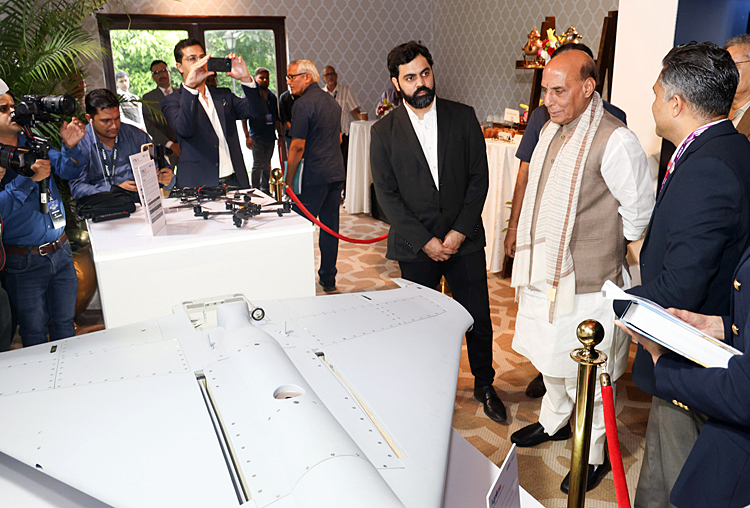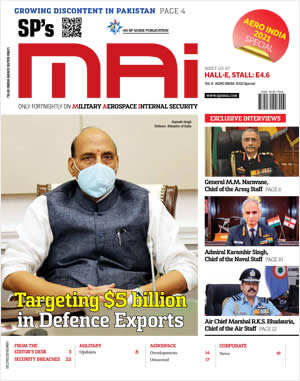INDIAN ARMED FORCES CHIEFS ON OUR RELENTLESS AND FOCUSED PUBLISHING EFFORTS

The insightful articles, inspiring narrations and analytical perspectives presented by the Editorial Team, establish an alluring connect with the reader. My compliments and best wishes to SP Guide Publications.

"Over the past 60 years, the growth of SP Guide Publications has mirrored the rising stature of Indian Navy. Its well-researched and informative magazines on Defence and Aerospace sector have served to shape an educated opinion of our military personnel, policy makers and the public alike. I wish SP's Publication team continued success, fair winds and following seas in all future endeavour!"

Since, its inception in 1964, SP Guide Publications has consistently demonstrated commitment to high-quality journalism in the aerospace and defence sectors, earning a well-deserved reputation as Asia's largest media house in this domain. I wish SP Guide Publications continued success in its pursuit of excellence.
- Indian Air Force Aims for Full Indigenous Inventory by 2047 — Air Chief Marshal A.P. Singh
- General Upendra Dwivedi takes over as the Chief of the Army Staff
- Rajnath Singh assumes charge as Defence Minister for the second consecutive term
- Admiral Dinesh K. Tripathi assumes Command of the Indian Navy as 26th Chief of the Naval Staff
- Prime Minister witnesses 'Bharat Shakti' – a Tri-Services Firing and Manoeuvre Exercise in Pokhran, Rajasthan
In today's era of terrorism, pandemics & regional conflicts, self-reliance in defence is not merely an option, but a condition for survival and progress: Defence Minister Rajnath Singh
India's victory & Pakistan's defeat in Operation Sindoor may appear to be a story of a war of a few days, but behind it lies years of strategic preparation & defense preparedness: Defence Minister

"In today's era of terrorism, pandemics and regional conflicts, self-reliance in defence is not merely an option, but a condition for survival and progress. It is not about protectionism, it is about sovereignty and national autonomy," stated Defence Minister Rajnath Singh during his address at a Defence Conclave with the theme 'Warfare in the 21st Century' in New Delhi on August 30, 2025. He highlighted that the conclave comes at a significant moment with India's Armed Forces displaying valour through Operation Sindoor just months ago, while conflicts, trade wars and instability continue to shape the global landscape. Rajnath Singh underlined that the geopolitical shifts have shown the nation that dependence on others for defence is no longer an option. He added that the Government, under the leadership of the Prime Minister Narendra Modi, has always believed that a self-reliant India alone can safeguard its strategic autonomy.
The Defence Minister stated that many developed nations are resorting to protectionist measures, with situations of trade war and tariff war becoming increasingly serious. He stressed that self-reliance in defence should not be confused with isolation. "This is not protectionism. It is about sovereignty. When a nation of youth, energy, technology and possibilities moves towards self-reliance, the world pauses and takes note. This is the strength that enables India to withstand global pressures and emerge stronger," he added.
"India seeks no enemies but will not compromise its interests. The welfare of our people, farmers & small businesses is our top priority. The more pressure the world applies, the stronger India emerges"
Rajnath Singh hailed Operation Sindoor as a shining example of India's growing indigenous defence capabilities. He said that the precise strikes carried out by the armed forces on their targets using indigenous equipment demonstrated that no mission can be successful without vision, long preparation and coordination. "Operation Sindoor may appear to be a story of a war of a few days, India's victory and Pakistan's defeat, but years of strategic preparation and defence preparedness have played a long role behind it," he added. He underscored that India's forces, through years of hard work and reliance on indigenous equipment, executed the operation effectively and decisively.
The Defence Minister described the Sudarshan Chakra Mission as a game-changing initiative for India's future security. Announced by the Prime Minister, the mission envisions providing complete aerial protection to critical locations across the country within the next decade, using both defensive and offensive technologies. Citing lessons from Operation Sindoor, he underlined the growing importance of air defence in modern warfare. Rajnath Singh further mentioned that DRDO successfully tested an indigenous integrated air defence weapon system on August 23, 2025, which hit three targets simultaneously, marking the first step towards realising the Prime Minister's vision. He expressed confidence that although full implementation will take time, the Ministry of Defence has already moved decisively forward in this direction.
"All our warships are now being built in India. The recent commissioning of stealth frigates INS Himgiri and INS Udaygiri, equipped with advanced weaponry and electronic warfare systems, reflects our Navy's resolve not to buy any warship from abroad. These ships are world-class, and will enhance India's strength in the Indian Ocean Region," stated Rajnath Singh while highlighting the indigenisation milestones such as complete self-reliance in warship construction.
Indigenous Air Defence System Test Marks First Step in Realising Sudarshan Chakra Mission: Defence Minister
The Defence Minister announced that the Government has taken up the challenge of developing and manufacturing a powerful indigenous aero-engine, an area where India had faced limited success for a long time. He pointed out preparations for this critical project are now almost complete and the work will soon be visible at the ground level. Stressing its importance, he underlined that earlier the question used to be whether India could build such advanced systems, but today the question has changed to how quickly they can be deployed.
Rajnath Singh underlined the creation of Defence Industrial Corridors in Uttar Pradesh and Tamil Nadu as a major step towards indigenisation and innovation. He said that these corridors have already started yielding positive results and hold the potential to be expanded to other states as well. By fostering clusters of defence manufacturing and innovation, the corridors are set to become engines of growth and strengthen India's vision of Aatmanirbhar Bharat in the defence sector.

Addressing India's transformation from importer to exporter, the Defence Minister highlighted that the defence exports have risen from under ₹700 crore in 2014 to nearly ₹24,000 crore in 2025. "India is no longer just a buyer but an exporter. This success is not only due to public sector units but also the contribution of private industry, start-ups and entrepreneurs," he said.
Rajnath Singh underlined the impact of the Positive Indigenisation Lists in promoting self-reliance in defence, stating that under these lists, it has been decided that more than 5,500 items will no longer be imported but manufactured in India within a fixed timeframe. He also informed that, so far, over 3,000 such items, which were earlier sourced from abroad, are now being produced indigenously.
Defence Minister Hails Role of Women Officers in Building a Modern, Inclusive Military
On the economic role of defence, the Defence Minister underscored that the sector has become a pillar of growth. "Domestic defence production has crossed ₹1.5 lakh crore, with 25 per cent from the private sector. Defence is not mere expenditure, it is Defence Economics, a driver of jobs, innovation and industrial growth. Like IT or automobiles, defence today is a growth multiplier," he added. He mentioned that lakhs of people are engaged directly and indirectly in manufacturing, R&D and allied activities.
Highlighting reforms to promote defence manufacturing, Rajnath Singh stated that the Government has made significant policy changes. "The process of defence licensing has been simplified, the FDI limit has been increased to 74 per cent, and the Make in India process has been streamlined to encourage greater private sector participation," he stated.
"For the first time, our youth are getting a platform to channel their talent into defence innovation. The iDEX scheme has revolutionised this space. Today, start-ups and innovators are delivering solutions that earlier we were dependent on others for. We are telling our youth, show your innovation, and wherever required, the Government will stand with you," said Defence Minister.
On an international stage, Rajnath Singh reiterated that India seeks no enemies but will not compromise its interests. "We do not consider any country our enemy. But the welfare of our people, farmers, small businesses and common citizens is our top priority. The more pressure the world applies, the stronger India emerges," he said.
Reflecting on the century so far, the Defence Minister stated that the world has witnessed disruptive challenges ranging from terrorism and the Covid-19 pandemic to conflicts in Ukraine, the Middle East and Africa. At the same time, technologies such as Artificial Intelligence, Quantum Computing and Space Science are redefining life and security. "This century is perhaps the most unstable and challenging. In such a world, India's only sustainable path is Aatmanirbharta," he said.
India Takes Major Step Towards Self-Reliance with Indigenous Aero-Engine Project
Rajnath Singh highlighted bold reforms in defence manufacturing, pointing to the corporatisation of the Ordnance Factory Board. "This was not just an administrative reform but freedom from a colonial legacy. From losses of nearly ₹3,000 crore in 2019-20, these units now post profits of over ₹1,600 crore after restructuring. This is a symbol of our nation freeing itself from the mindset of slavery," he said. He credited the Government's vision of Make in India and Aatmanirbhar Bharat for bringing a revolutionary change in defence. "By sticking to old systems we could not meet the aspirations of a new India. That is why we reorganised forces and took the historic decision to induct women into combat. Today, women officers are flying fighter jets, navigating ships, and defending our borders in the most difficult terrains," he said.
The Defence Minister reminded the audience that indigenous technological advances from aircraft carriers & fighter jets to drones, radar and missile systems had overcome the restrictions imposed after Pokhran 1998. "Today, the world knows India has the capability to decisively defeat its adversaries within minutes. These achievements are proof of our technological and industrial strength," he said.
Addressing the media's role, he called for sensitivity in times of war. "A small report can raise the morale of millions, but a mistake can cost lives. In conflict, freedom and responsibility must go hand in hand. The media is the fourth pillar of democracy, but also becomes the watchdog of national security," Rajnath Singh cautioned.
In the end, the Defence Minister said, "Aatmanirbhar Bharat in defence is not a slogan, but a roadmap for India's security, sovereignty, and progress. In the coming years, India will not only fulfil its own needs, but also become a reliable partner for the world. This vision will establish India as a decisive power in the 21st century." Defence Secretary Rajesh Kumar Singh was also present on the occasion.





